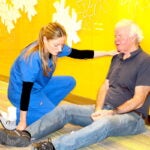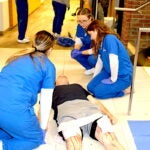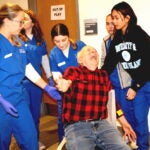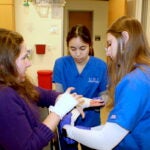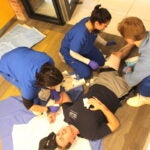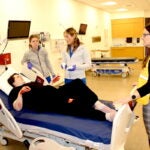URI nursing students spring into action when ‘victims’ flood simulated ER
University of Rhode Island Nursing students got a chance to handle a mass casualty event during a simulated exercise at the Nursing Education Center in Providence on Jan. 20, giving them a feel for the sudden chaos that can erupt in a health care setting and the need to be ready to respond to any circumstance at a moment’s notice.
Sixteen actors portrayed protesters who were run down by an SUV during a fictitious demonstration in Providence. Victims suddenly flooded the nursing college, the nearest facility to the incident with medical professionals, surprising students who jumped to action to treat injuries ranging from minor to critical. Some came in with bumps and bruises; others with open wounds dripping fake blood, one even with compound fractures to both legs. Some patients were screaming and crying; others appeared to be confused about what happened or where they were, apparently experiencing head trauma.
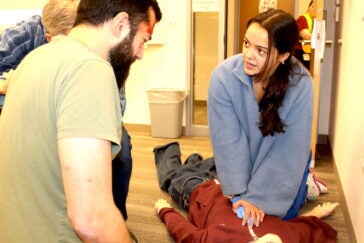 Through three rounds of simulations, about 50 URI students worked together to patch up patients, comfort those traumatized by the incident, prioritize the most urgent cases and prepare them for transport to hospitals for further treatment, all in a location without the abundance of medical supplies found in a hospital.
Through three rounds of simulations, about 50 URI students worked together to patch up patients, comfort those traumatized by the incident, prioritize the most urgent cases and prepare them for transport to hospitals for further treatment, all in a location without the abundance of medical supplies found in a hospital.
“The students have to understand you don’t always have what you need around; they had to rely on each other to get the job done with whatever they had,” said Jessica Skaltsis, acting undergrad simulation coordinator for URI’s College of Nursing. “They come away with a perspective that I just always need to be ready.”
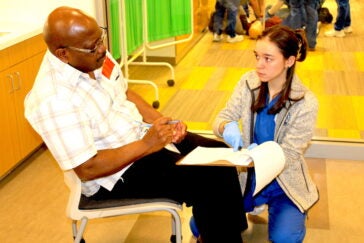 The college’s Simulation Program fosters the development of evidence-based knowledge, skills, and competencies required for high-quality, patient care in complex environments. The labs at the NEC simulate health care in a variety of settings, including a hospital room, mass casualty location and in-home care. Simulation prepares nursing students to develop competencies to manage real patient situations in a safe learning environment. It provides a safe environment for students to learn without risking patient safety. It enhances critical thinking, teamwork and communication skills. It also allows for repeated practice and skill refinement, which may not be possible in real clinical settings with actual patients.
The college’s Simulation Program fosters the development of evidence-based knowledge, skills, and competencies required for high-quality, patient care in complex environments. The labs at the NEC simulate health care in a variety of settings, including a hospital room, mass casualty location and in-home care. Simulation prepares nursing students to develop competencies to manage real patient situations in a safe learning environment. It provides a safe environment for students to learn without risking patient safety. It enhances critical thinking, teamwork and communication skills. It also allows for repeated practice and skill refinement, which may not be possible in real clinical settings with actual patients.
“Sim allows for safe, repetitive practice, so when they find themselves in a real situation, it’s almost a reflex,” Skaltsis said. “Simulation gives them a foundation to draw from, a sort of muscle memory so they’ll be able to react in a real-world situation because they’ve had exposure to it.”


